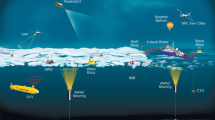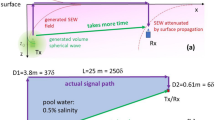Abstract
In the search for life, one of NASA’s priorities is in-situ exploration of ocean worlds in the solar system where there might be life under the ice shell. This requires the ocean below the ice shell to be reached by traversing through great ice depths that are extremely cold. Europa, one of Jupiter’s moons, is one such challenging planetary body; its ice shell is estimated to be 40 km deep. An approach has been conceived to reach the ocean using a Cryobot, which is a melting probe with a lander as the platform for its deployment. This ice-penetrating vehicle concept consists of a cylindrical, narrow-bodied probe that encases a radioisotope heat/power source to melt through the icy shell. The probe would include a suite of scientific instruments to analyze both the ice during descent and the ocean water underneath. For communication, a set of fiber optic wire and wireless radio frequency (RF) in the very cold porous top layer is assumed, and then acoustic modules are used for communication in the warmer denser ice over a distance of 25 km between modules. In addition to the acoustic communication modules, a sonar is used to avoid obstacles and determine the distance from the ice‒water interface region. The focus of this chapter is the use of elastic waves for wireless communication and sonar for operation through great ice depths.
Access this chapter
Tax calculation will be finalised at checkout
Purchases are for personal use only
Similar content being viewed by others
References
Abbasi, R., Y. Abdou, T. Abu-Zayyad, J. Adams, J.A. Aguilar, M. Ahlers, K. Andeen, et al. 2011. Measurement of acoustic attenuation in South Pole ice. Astroparticle Physics 34 (6): 382–393.
Bar-Cohen, Y. (Ed.). 2016. Low Temperature Materials and Mechanisms, ISBN-10: 1498700381, ISBN-13: 978–1498700382, CRC Press, Taylor & Francis Group, Boca Raton, FL, 500 pages.
Bar-Cohen, Y., and K. Zacny (Eds). 2020. Advances in Terrestrial and Extraterrestrial Drilling (Design, Modeling, and Specialized Techniques for Extreme Environments), Vol. 2: Advances in Extraterrestrial Drilling, ISBN-10: 0367653478; ISBN-13: 978–0367653477; CRC Press/Taylor & Francis Group LLC, Boca Raton, Florida, 364 pages.
Benjamin, K. 2008. Transducers for sonar systems. In Handbook of Signal Processing in Acoustics, 1783–1819. New York: Springer.
Benson, B., Y. Li, B. Faunce, K. Domond, D. Kimball, C. Schurgers, and R. Kastner. 2010. Design of a low-cost underwater acoustic modem. IEEE Embedded Systems Letters 2 (3): 58–61.
Cwik, T. et al. 2018. A technology architecture for accessing the oceans of icy worlds. 69th International Astronautical Congress (IAC), IAC-18-A7.3.4, Bremen, Germany, 1–5 October 2018.
Di Pippo, S., R. Mugnuolo, P. Vielmo, and W. Prendin. 1999. The exploitation of Europa ice and water basins. Planetary and Space Science 47: 921–933.
Dogan, A., K. Uchino, and R.E. Newnham. 1997. Composite piezoelectric transducer with truncated conical endcaps ‘Cymbal.’ IEEE Transactions on Ultrasonics, Ferroelectrics, and Frequency Control 44 (3): 597–605.
Dooley, J.A., C. Lindensmith, R. Chave and N. Good. 1999. Magnetostriction of single crystal and polycrystalline Tb0.60Dy0.40 at cryogenic temperatures. Journal of Applied Physics 85(8), 6256‒6258. https://doi.org/10.1063/1.370128
Fleurial, J.-P., S. Howell, D. Woerner, D. Landau, J. Gayle, M. Smith, J. Mueller, T. Hendricks, S. Roberts, B. Nesmith, S. Bryant, Y. Bar-Cohen, E. Klonicki, W. West, B. Hockman and B. Clement. 2019. Notional Concept of Operations and System Capability Definition for Enabling Scientific Ocean Access Missions on Icy Worlds. paper No. EPSC-DPS2019–1268, OPS3/EXO16—Ocean Worlds and Icy Moons—EPSC-DPS Joint Meeting.
Hand, K.P., and the Project Engineering Team. 2017. Report of the Europa Lander Science Definition Team, Tech. Rep. JPL D-97667, NASA.
Jiang, X., and P.W. Rehrig. 2005. Advanced piezoelectric single crystal based actuators. presented at the Proc. of SPIE.
Kowalski, J., P. Linder, S. Zierke, B. von Wulfen, J. Clemens, K. Konstantinidis, G. Ameres, R. Hoffmann, J. Mikucki S.Tulaczyk O. Funke, D. Blandfort, C. Espe, M. Feldmann, G. Francke, S. Hiecker, E. Plescher, S. Schöngarth and K. Helbing. 2016. Navigation technology for exploration of glacier ice with maneuverable melting probes. Cold Regions Science and Technology, Elsevier 123, 53–70https://doi.org/10.1016/j.coldregions.2015.11.006
Lee, S., M. Zanolin, A.M. Thode, R.T. Pappalardo, and N.C. Makris. 2003. Probing Europa’s interior with natural sound sources. Icarus 165 (1): 144–167.
Lee, S., R.T. Pappalardo, and N.C. Makris. 2005. Mechanics of tidally driven fractures in Europa’s ice shell. Icarus 177 (2): 367–379.
Lishman, B., J. Wadham, B. Drinkwater, J. Kendall, S. Burrow, G. Hilton, and I. Craddock. 2013. Assessing the utility of acoustic communication for wireless sensors deployed beneath ice sheets. Annals of Glaciology 54 (64): 124–134. https://doi.org/10.3189/2013AoG64A022
Mulvihill, M.L., R.J. Shawgo, R.B. Bagwell, et al. 2002. Cryogenic cofired multilayer actuator development for a deformable mirror in the next generation space telescope. Journal of Electroceramics 8: 121–128. https://doi.org/10.1023/A:1020551812502
National Research Council Space Studies Board. 2012. Vision and voyages for planetary science in the decade 2013–2022. National Academies Press.
National Research Council Space Studies Board. 2018. Astrobiology Science Strategy for the Search for Life in the Universe. National Academies Press.
Panning, M.P., et al. 2018. Expected seismicity and the seismic noise environment of Europa. Journal of Geophysical Research—Planets 123 (1), 163‒179.
Pappalardo, R.T., L.M. Prockter, D.A. Senske, R. Klima, S.F. Vance, K. Craft, and the Europa Science Team. 2016. Science objectives and capabilities of the NASA Europa mission. 47th Lunar and Planetary Science Conference #3058.
Shannon, C.E. 1949. Communication in the presence of noise. Proceedings of the Institute of Radio Engineers 37 (1): 10–21.
Sherman, C.H., and J.L. Butler. 2007. Transducers and Arrays for Underwater Sound. New York: Springer.
Stojanovic, M., and J. Preisig. 2009. Underwater acoustic communication channels: Propagation models and statistical characterization. IEEE Communications Magazine 47 (1): 84–89.
Teledyne Marine. 2019. Acoustic modems 960 Series ATM-966. http://www.teledynemarine.com/960-series-atm-966?ProductLineID=8 (Oct. 23 2019).
Tressler, J., and R. Newnham. 1999. Capped ceramic underwater sound projector: The “cymbal” transducer. The Journal of the Acoustical Society of America.
Tressler, J.F., T.R. Howarth, and D. Huang 2006. A comparison of the underwater acoustic performance of single crystal versus piezoelectric ceramic-based “cymbal” projectors. The Journal of the Acoustical Society of America.
Urick R.J. 1975. Principle of underwater sound, 16‒28, 2nd edition. McGraw-Hill Books.
Vandenbroucke, J., and IceCube Collaboration. 2009. Measurement of acoustic properties of South Pole ice for neutrino astronomy. Nuclear Instruments and Methods in Physics Research Section a: Accelerators, Spectrometers, Detectors and Associated Equipment 604 (1): S164–S170.
Whalen S.A., A.A. Christopher, and L.A. Terrence. 2008. Improving power density and efficiency of miniature radioisotopic thermoelectric generators. Journal of Power Sources 180 (1): 657–663.
Zhang, S., H.J. Lee, and S. Sherrit. 2016. Low temperature transducing materials. Chapter 7 in Bar-Cohen Y. (Ed.), (2016), Low Temperature Materials and Mechanisms, ISBN-10: 1498700381, ISBN-13: 978–1498700382, CRC Press, Taylor & Francis Group, Boca Raton, FL, pp. 183‒212.
Zimmerman W. et al. 1998. Europa Cryo-Hydro Integrated Robotic Penetrator System (CHIRPS) Feasibility Study, Jet Propulsion Laboratory/ California Institute of Technology, July 1998.
Zimmerman W., S. Bryant, J. Zitzelberger and B. Nesmith. 2001a. Radioisotope powered Cryobot for penetrating the Europan ice shell. American Institute of Physics Conference Proceedings 552, 707.
Zimmerman, W., R. Bonitz, and J. Feldman. 2001b. Cryobot: An ice penetrating robotic vehicle for Mars and Europa. IEEE Aerospace Conference Proceedings 1: 1311–1323.
Acknowledgements
Research reported in this abstract was conducted at the Jet Propulsion Laboratory (JPL), California Institute of Technology, under a contract with National Aeronautics Space Administration (NASA). This chapter also presents the latest results from an ongoing JPL formulation and technology development effort for the Europan melt probe “PRIME—Probe using Radioisotopes for Icy Moons Exploration”, which was funded by an internal award. The authors would like to thank the PRIME team members who contributed to the conception of the Cryobot configuration that is reported in this chapter. They include Scott H. Bryant, Jean-Pierre Fleurial, Jeremiah B. Gayle, Terry J. Hendricks, Samuel M. Howell, Emily F. Klonicki, Juergen Mueller, Knut I. Oxnevad, Adarsh Rajguru, Miles Smith and David F. Woerner, Jet Propulsion Laboratory/California Institute of technology.
Author information
Authors and Affiliations
Corresponding author
Editor information
Editors and Affiliations
Rights and permissions
Copyright information
© 2023 This is a U.S. government work and not under copyright protection in the U.S.; foreign copyright protection may apply
About this chapter
Cite this chapter
Bar-Cohen, Y. et al. (2023). Communication and Obstacles Detection Using Piezoelectric Transducers in a Penetrator Melting Deep Ice on Ocean Worlds. In: Badescu, V., Zacny, K., Bar-Cohen, Y. (eds) Handbook of Space Resources. Springer, Cham. https://doi.org/10.1007/978-3-030-97913-3_28
Download citation
DOI: https://doi.org/10.1007/978-3-030-97913-3_28
Published:
Publisher Name: Springer, Cham
Print ISBN: 978-3-030-97912-6
Online ISBN: 978-3-030-97913-3
eBook Packages: Physics and AstronomyPhysics and Astronomy (R0)




